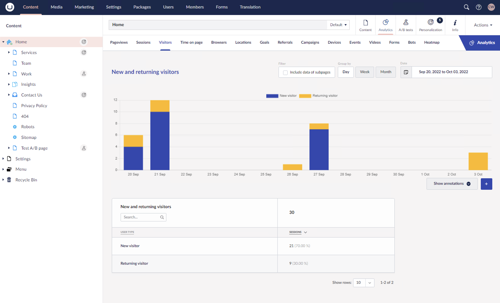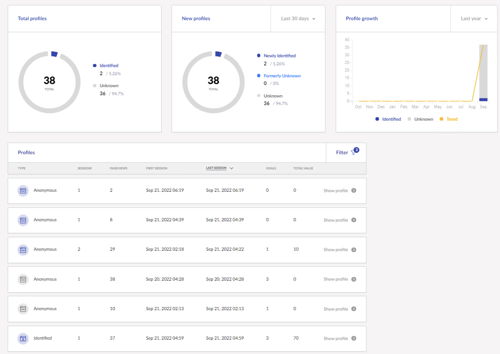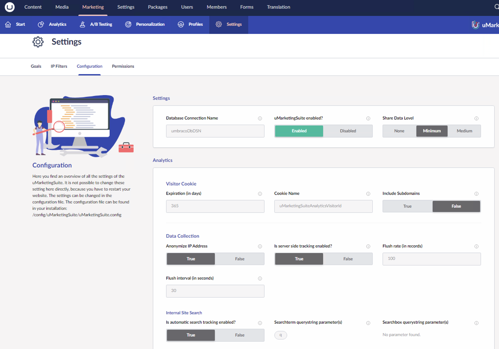Umbraco and uMarketingSuite - analytics, profiles & debugging

Photo by Scott Graham on Unsplash
This is the 3rd instalment in a blog series on Umbraco and uMarketingSuite. Across this series we will be looking at how to use these platforms to build and deliver website personalisation, testing, analytics and all that good stuff. This final post will cover how to use uMarketingSuite analytics, profiles and the awesome debugging tool called 'Cockpit'. If you are new to Umbraco and uMarketingSuite, please start with the first two blog posts.
Let's look at the setup steps involved, using the Aceik website (aceik.com.au) as an example.
Analytics
uMarketingSuite generates both serverside (out-of-the-box) and clientside (via additional script) analytics. If you are familiar with Google Analytics, the breadth and type of analytics in uMarketingSuite will be easy to navigate. It has all the main types of reporting a website marketer will expect.

I like how Analytics can be accessed from a central location within the Marketing menu but also specific to each content node as well.

Additional data insight you get at the content node level is heatmaps. This report shows a visual representation of the scroll depth of users on each page.
Unfortunately, there does not appear to be any way to export website analytics data out of Umbraco nor can you combine any offline or external data sources with your website data. Although there is an existing bridging javascript file for classic Google Analytics events, I have not been able to determine if there are currently or plans to be able to integrate Google Analytics 4 events into uMarketingSuite. This would be a handy feature.
Profiles
uMarketingSuite Profiles provides you with an overview of all the visitors that visited your website. This is kind of like a mini, simplified, and streamlined CDP (customer data platform). In Profiles, you can see the activity of each visitor, including whether they have identified or not, the goals they have completed, pages they have visited, and so forth. A visitor becomes identified when they submit any Umbraco form on your website containing identifying information such as name and email.

Similarly to Analytics, it does not appear that you can do much with this profile data beyond the reports that are provided. You cannot export or integrate this data beyond the uMarketingSuite platform.
Settings
There are several configuration settings you can modify concerning the uMarketingSuite. Many of these options will be familiar to you based on Google Analytics. For example, you can set site cookie details, sub-domain options, site search settings, and IP filters for excluding internal site visitors. There are fewer options than what comes with Google Analytics, but they are easy to access and modify within a couple of screens.

Debugging with Cockpit
One of the stand-out features of using uMarketingSuite for personalisation and testing is the debugging tool called Cockpit. Once cockpit is activated, it will appear as a widget whenever you are logged in to Umbraco and browsing your website.
Using cockpit you can
- See live analytics data as it's recorded while you browse
- Delete uMarketingSuite cookies with 1 click
- See live Persona, Journey and Segment data update in real-time as you browse
- Click through to see your current Profile as recorded in Umbraco
- Visit the website as any existing segment
- Click through to edit any content node
What this means in practice is that debugging and previewing personalisations and tests in real-time is super easy. If something is not working as expected, it is easy to determine what is wrong. If you need to review any particular experience, it is quick to do.
Throughout any reasonably-sized optimisation project, this tool alone will save you hours, compared to manual testing and validating each variation.

Using this tool, I realised that uMarketingSuite uses 'control' groups who do not see any particular test and personalisation even when their scores meet the threshold. In my experience, this is the reason 90% of the time why an experience is not appearing when you expect it to. If you find yourself in a control group, simply clear the uMarketingSuite cookie to reset this.
The other thing to note with uMarketingSuite personalisations is that visitors can only be active within 1 persona and journey group at a time. If you need users to be active across multiple personas, you will need to separate them into different groups.
Conclusion
Across these 3 short blog posts, we have covered the foundation work to set up and implement personalisation, A/B tests, analytics, profiles and more across your website using Umbraco and uMarketingSuite.
I hope this has been a useful series and if you want to talk more about your website optimisation needs, please feel free to get in touch!
For more information about Aceik’s Sitecore Optimisation Packages, please contact us!